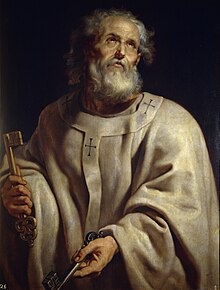
Saint Peter
Christian apostle / From Wikipedia, the free encyclopedia
Dear Wikiwand AI, let's keep it short by simply answering these key questions:
Can you list the top facts and stats about Saint Peter?
Summarize this article for a 10 year old
Saint Peter[note 1] (Imperial Aramaic: 𐡔𐡌𐡏𐡅𐡍 𐡁𐡓 𐡉𐡅𐡍𐡄, romanized: Shimoun Bar Younah; died AD 64–68),[1] also known as Peter the Apostle, Simon Peter, Simeon, Simon, or Cephas (Imperial Aramaic: 𐡊𐡉𐡐𐡀, romanized: Kipa, lit. 'Rock'),[6] was one of the Twelve Apostles of Jesus Christ and one of the first leaders of the early Christian Church. He appears repeatedly and prominently in all four New Testament gospels as well as the Acts of the Apostles. Catholic tradition accredits Peter as the first bishop of Rome—or pope—and also as the first bishop of Antioch.
Peter the Apostle | |
|---|---|
 Saint Peter (c. 1610–1612) by Peter Paul Rubens, depicting Peter, vested in the pallium, and holding the Keys of Heaven | |
| Church | Early Christian |
| See |
|
| Papacy began | AD 30[1] |
| Papacy ended | Between AD 64 and 68[1] |
| Successor | |
| Orders | |
| Ordination | by Jesus Christ, AD 30 |
| Personal details | |
| Born | Shimoun Bar Younah (Imperial Aramaic: 𐡔𐡌𐡏𐡅𐡍 𐡁𐡓 𐡉𐡅𐡍𐡄) (Simeon, Simon) c. AD 1 |
| Died | Between AD 64 and 68 (aged 62–67) Vatican Hill, Rome, Italia, Roman Empire[3][4] |
| Parents | John (or Jonah; Jona) |
| Occupation | Fisherman, clergyman |
| Sainthood | |
| Feast day |
|
| Venerated in | All Christian denominations that venerate saints and in Islam |
| Canonized | Pre-Congregation |
| Attributes | Keys of Heaven, Red Martyr, pallium, papal vestments, man crucified upside down, vested as an Apostle, holding a book or scroll, Cross of Saint Peter |
| Patronage | Patronage list |
| Shrines | St. Peter's Basilica Church of St. Peter |
According to Christian tradition, Peter was crucified in Rome under Emperor Nero. The ancient Christian churches all venerate Peter as a major saint and as the founder of the Church of Antioch and the Church of Rome,[1] but they differ in their attitudes regarding the authority of his successors. According to Catholic teaching, Jesus promised Peter a special position in the Church.[7] In the New Testament, the name "Simon Peter" is found 19 times. He is the brother of Saint Andrew, and they both were fishermen. The Gospel of Mark in particular was traditionally thought to show the influence of Peter's preaching and eyewitness memories. He is also mentioned, under either the name Peter or Cephas, in Paul's First Letter to the Corinthians and the Epistle to the Galatians. The New Testament also includes two general epistles, First Peter and Second Peter, that are traditionally attributed to him, but modern scholarship generally rejects the Petrine authorship of both.[8] Nevertheless, Evangelicals and Catholics have always affirmed Peter's authorship, and recently, evangelical scholars have revived the claim of Petrine authorship of these epistles.[9]
Based on contemporary historical data, Peter's papacy is estimated to have spanned from AD 30 to his death, which would make him the longest-reigning pope, at anywhere from 34 to 38 years; however, this has never been verified.[1]
Saint Irenaeus (c. 130 – c. 202 AD) explains the Apostle Peter, his See, and his successors in book III of Adversus Haereses (Against Heresies).[10] In the book, Irenaeus wrote that Peter and Paul founded and organised the Church in Rome.[11]
Sources suggest that at first, the terms episcopos and presbyteros were used interchangeably,[12] with the consensus among scholars being that by the turn of the 1st and 2nd centuries, local congregations were led by bishops and presbyters, whose duties of office overlapped or were indistinguishable from one another.[13] Protestant and secular historians generally agree that there was probably "no single 'monarchical' bishop in Rome before the middle of the 2nd century...and likely later."[14] Outside of the New Testament, several apocryphal books were later attributed to him, in particular the Acts of Peter, Gospel of Peter, Preaching of Peter, Apocalypse of Peter, and Judgment of Peter, although scholars believe these works to be pseudepigrapha.[15][16][17]